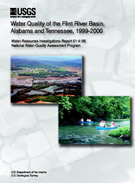

 |
Water Quality of the Flint River Basin, Alabama and Tennessee, 1999-2000U.S. Geological Survey, Water-Resources Investigations Report 01-4185 by Anne B. Hoos, Jerry W. Garrett, and Rodney R. Knight This report is available as a pdf below |
The U.S. Geological Survey monitored eight stream sites in the Flint River Basin during the period January 1999 through May 2000, to characterize patterns in the occurrence of pesticides, fecal-indicator bacteria, and nutrients in relation to season and streamflow conditions and to land-use patterns. This study is part of the National Water-Quality Assessment Program, which was designed to assess water quality as it relates to various land uses.
Every water sample collected from the Flint River Basin had detectable levels
of at least two pesticides; 64 percent of the samples contained mixtures of
at least five pesticides. In general, pesticides detected most frequently and
at highest concentrations in streams corresponded to the pesticides with the
highest rates of use in the watersheds. Detections of fluometuron, norflurazon,
and atrazine were more frequent (by a margin of 15 percent or more) in samples
from the Flint River when compared with the frequencies of pesticide detections
at 62 agricultural stream sites across the Nation. Detections of fluometuron
in the Flint River were more frequent even when compared with a cotton-cultivation
subset of the 62 sites. For most pesticides, maximum concentrations did not
exceed criteria to protect aquatic life; however, maximum concentrations of
atrazine, cyanazine, and malathion exceeded aquatic-life criteria in at least
one sample. Concentrations near or exceeding the aquatic-life criteria occurred
only during the spring and summer (April-July), and generally occurred during
storm flows.
Less than 5 percent of the estimated mass of pesticides applied annually to
agricultural areas in the Flint River Basin was transported to the stream at
the monitoring points on the Flint River near Brownsboro, Alabama, and on Hester
Creek near Plevna, Alabama. The pesticides with the highest ratios (greater
than 3 percent) of the amount transported instream to the amount applied—atrazine,
metolachlor, fluometuron, and norflurazon—are preemergent herbicides applied
to the soil before the crops have emerged, which increases the probability of
transport in surface runoff.
Concentrations of the fecal-bacteria indicator Escherichia coli (E.
coli) in the Flint River and Hester Creek exceeded the U.S. Environmental
Protection Agency criterion for recreation in almost all storm samples, and
in many samples collected up to 6 days following a storm. Concentrations in
the Flint River were strongly correlated with sample turbidity, suggesting that
turbidity might be useful as a surrogate for estimating E. coli concentrations.
Concentrations of the nutrients nitrogen and phosphorus in samples from the
Flint River generally exceeded thresholds indicating eutrophic potential, whereas
concentrations in samples from Hester Creek were generally below the thresholds.
When compared with nutrient data from a set of 24 agricultural basins across
the southeastern region of the United States, concentrations in the Flint River
and Hester Creek were slightly above the regional median.
Base-flow concentrations of certain pesticides, nutrients, and E. coli
were compared to land-use information for eight sites in the Flint River Basin.
The highest base-flow concentrations of aldicarb sulfoxide, fluometuron, and
phosphorus were found in the tributaries with the greatest density of cotton
acreage in the watershed. Similarly, high base-flow concentrations of total
nitrogen were correlated with a high percentage of cultivated land in the watershed.
Lack of information about distribution of stream access by livestock weakened
the analysis of correlation between livestock and base-flow concentrations of
E. coli and nutrients.
Input of dissolved and suspended chemicals from the Flint River during storms
influences water quality in the reach of the Tennessee River from which the
City of Huntsville, Alabama, withdraws about 40 percent of its drinking water.
During the storm of April 2-5, 2000, concentrations of several pesticides were
at least a factor five times greater in Huntsville's intake water when
compared with concentrations in the Tennessee River upstream from the Flint
River, although concentrations of all pesticides were below the U.S. Environmental
Protection Agency drinking-water standards at all sites on the Tennessee River
and in Huntsville's intake water.
| AccessibilityFOIAPrivacyPolicies and Notices | |
 |
|